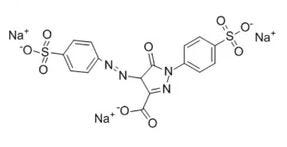Dye, Baby, Dye!
Recently there was an amazing discovery at the University of Texas in Dallas. They found that if they applied the compound tartrazine on the skin of live mice, the solution would make the mice’s skin translucent.
That’s right. Tartrazine allowed scientists to see right through the skin, into the tissues beneath, potentially offering a simple and inexpensive alternative to conventional imaging technologies like ultrasound.
Through the skin covering the skull, the scientists could look directly at blood vessels on the surface of the brain, and through the skin of the abdomen they observed internal organs and even the process known as peristalsis, the contractions that move food through the digestive passage.
Holy cow!
Next, tartrazine will be tested on humans.
Where did this miracle substance come from? Actually, tartrazine has been around for a while. Maybe you know it by a different name, the food additive Yellow Dye #5.
Yes, this chemical that can make skin transparent, is found in Twinkies, Mountain Dew, candies, and cereals, among other foods. Tartrazine has been linked to hyperactivity in children and cancer. In the European Union, foods containing tartrazine must carry the warning label: “May have an adverse effect on activity and attention in children.” In fact, tartrazine has been reported to trigger allergic reactions in people who suffer from asthma and in those who have an intolerance to aspirin and is thus banned in countries like Sweden, Switzerland, Norway and Austria.
So, where does tartrazine come from? Any idea? How about coal tar. Yup, from the tar derived from burning coke, the coal used to heat iron to make steel. The discovery was accidental when, in 1856, a British chemist was trying to create synthetic quinine, which was used to treat malaria, from the benzine found in coal tar. Benzine! What was once a waste product dumped into waterways by gas and coal companies became the source of a rainbow of beautiful dyes.
What were known in the 19th century as “coal tar colors” weren’t completely safe, with workers in coal tar factories developing bladder cancer, but they were safer than the alternative. For example, before the new dyes, in order to make pickles, jellies, and candy more vivid, manufacturers added dangerous metal salts such as copper sulfate and lead chromate. In contrast, coal tar dyes were so vivid that only a little was needed. Plus, the tiny amount meant that the product’s flavor wasn’t affected.
So, knowing what we know, was tartrazine ever tested and declared safe by the Food and Drug Administration (FDA)?
No.
In the 1958 Food Additive Amendments, the FDA created the concept of GRAS, or “generally recognized as safe.” They did this for their convenience because it meant that any food additive that had been in use at that time was grandfathered in the “safe” list, merely because no one ever said it was unsafe.
Got it?
The GRAS loophole also allowed companies to test additives themselves and then adding them to their food products without any consultation with the FDA. Without GRAS the feckless FDA couldn’t keep up with the number of food additives created.
According to one study, since 2000, there have been only 10 applications to the FDA for full approval of a new food additive, out of a total of 766 that have been added to the American food supply. The safety of the other 756 was self-determined by the manufacturers themselves, in secret.
* * *
Over the last few years, there has been a revival of healthy eating. We’ve been through a bunch of fads: the Mediterranean diet, low fat foods, the Adkins diet, the Keto diet, high fiber diets, etc. None of these seem to have had a lasting effect on the U.S. population. Yet, we’re as fat and unhealthy as we’ve ever been.
In the book Good Energy, authors Casey and Calley Means outline healthy eating, its benefits and how to get to better eating habits. They clearly relate that to improve our health we need to reject ultra-processed foods, in favor of natural and organic foods.
They define ultra-processed foods as those that “are created in industrial factories by combining various extracted and adulterated parts from different foods with synthetic ingredients like preservatives and food colorings.” They refer to these as “Frankenfoods” that we should never eat or give to our kids.
Foods that have ingredients like tartrazine.
According to the Mayo Clinic, we should avoid foods that have:
Five or more ingredients.
Added sugar, salt, oils, fats, stabilizers and preservatives.
Additives that imitate the flavor, color or texture of less processed foods.
Ingredients not found in nature, such as high fructose corn syrup.
Obviously, the Good Energy authors wrote a whole book about all this. But to paraphrase, here are some thoughts:
Strive to eat as much unprocessed food as possible. Organic fresh fruit and vegetables, for example.
Avoid ultra-processed foods at all costs. This includes mass-produced versions of pastries, breads, cookies, nut milks (BTW, who knew that oats and almonds lactated?), most “nuggets”, power bars and basically any snack foods.
Only use “processed culinary ingredients” – those that are extracted from natural foods or nature by milling, pressing, drying, etc. Foods like butter, sugar, maple syrup, salt, etc. that are rarely consumed by themselves.
I’ll add to all this that if you read the ingredients list on a food label and you can’t pronounce some of the ingredients or you never heard of them, you should probably put that item back on the store shelf.
There’s been an increasing recognition that there’s something wrong with the foods that Americans are eating. It’s good that more of us are taking this seriously in our day-to-day lives.
Bon appétit!


